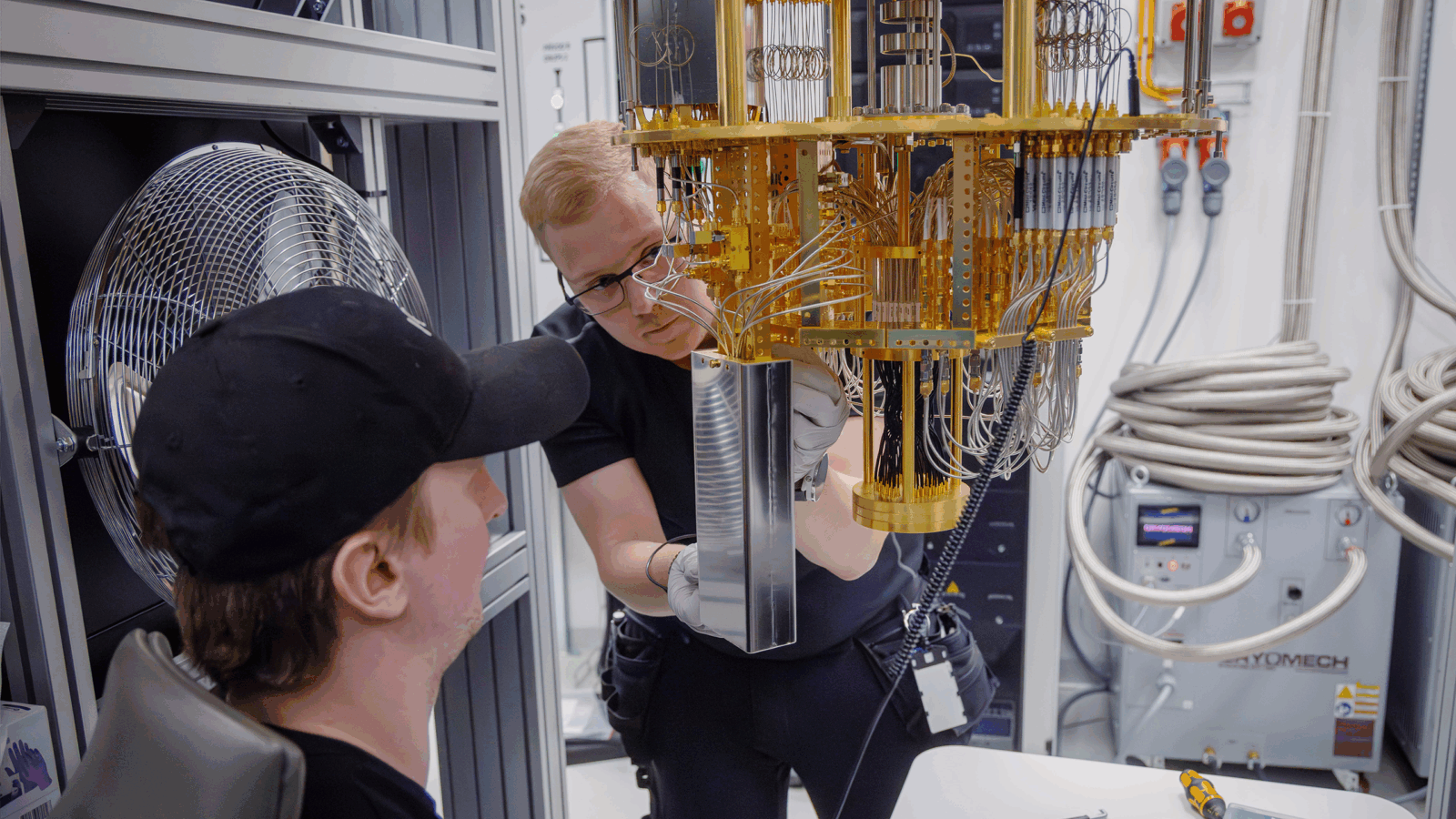Happy Thursday, and welcome to CIO Upside.
Today: Breakthroughs in quantum are becoming more frequent as Big Tech and governmental bodies turn their attention to it – and enterprises should keep their eyes open, too. Plus: How to start thinking about AI for your finance teams; and IBM’s patent helps AI models kick bad habits.
Let’s jump in.
Why is the Quantum Race Moving Faster?

Quantum breakthroughs are picking up the pace.
In mid-June, IBM released its quantum roadmap, outlining a path to “IBM Quantum Starling,” what the company expects to be the “first large-scale, fault-tolerant quantum computer,” by 2029. Nvidia CEO Jensen Huang, meanwhile, said during his keynote speech at the GTC Paris developer conference last week that quantum computing is “reaching an inflection point” and that applicable quantum computers are “within reach.”
The announcements add to a deluge of breakthroughs from tech firms throughout the past six months, including quantum computing chips from giants like Google, Amazon and Microsoft. With so much weight behind the movement, the future of quantum is looking less murky by the day, said John Levy, CEO of quantum computing architecture firm SEEQC.
“The large companies working in quantum, nearly all of them are focused on building better (quantum bits),” said Levy. “The better the quality of the qubit, the better the quality of the system.”
Emerging from ‘Deep R&D’
For a long time, quantum has been stuck in “deep R&D,” confined to labs and theory rather than considered for practical applications, said Levy. Interest from the trendsetters and decision-makers of tech, however, has brought development out of the shadows:
- Developers’ questions aren’t focused on whether quantum is possible, but rather how it can scale, said Levy.
- “A whole bunch of fundamental risk has been taken off the table,” Levy said. “Now we have new risks.”
Barriers to scaling still exist, he noted, including energy efficiency, error correction and running algorithms that actually bring value. At SEEQC, Levy’s team is seeking to tackle the problem of quantum’s complicated infrastructure, using its single flux quantum processors to allow for control over quantum systems without excessive hardware or energy usage.
The company recently announced a partnership with IBM as part of DARPA’s Quantum Benchmarking initiative, which would use SEEQC’s processors within IBM’s large-scale quantum computer in development. “This is all about scaling quantum computers,” Levy said. “And scaling doesn’t just mean adding more qubits.”
Though overcoming some barriers simply reveals more, the interest in developing quantum technology is only growing. As the timeline for scalable quantum computers grows shorter and shorter, enterprise leaders shouldn’t write the tech off as fringe, Levy said. For now, CIOs and tech leaders should keep an eye on road maps like IBM’s, seeing how it intersects with their own ideas of quantum and how it applies to their businesses.
Quantum may eventually catch enterprises that keep their heads in the sand off-guard, Levy said, just as the initial AI wave threw many unprepared companies into a tailspin.
“I don’t think we can think of this as business as usual,” he said. “ One step at a time, we’re doing it as an industry. And those steps are coming faster.”
Finance Departments Struggle to Balance AI Adoption Risks With Rewards

If you’re not considering how to work AI into your finance team, you may be behind the curve.
While doing so involves additional hurdles and higher stakes than adding AI to other departments in an enterprise, the benefits that the tech can bring – and the ability to stay ahead of competition – may be worth the hassle, experts told CIO Upside as part of our first-ever webinar.
“Opportunities for AI in finance are ultimately going to become as routine as using spreadsheets,” said Mel Walker, managing director and data and AI practice leader at CohnReznick.
‘Essential’ Personnel
There are tons of ways to put AI to use in financial departments, said L.E.K. Managing Director and Partner Chuck Reynolds. Enterprises should invest in a “portfolio of solutions” to adopt AI across their finance teams:
- Reynolds sees AI advancements in three key areas: performance enhancement, competitiveness and unique revenue streams. Areas like fraud detection and accounts payable and receivable, he said, are ripe for automation.
- The introduction of AI agents, Reynolds noted, has the capability to make these processes even more efficient and seamless.
- “It’s imperative for organizations to adopt AI,” he said. “If you’re not doing this, your competitors will be.”
The stakes, however, are quite high, Walker said. Without total confidence in the outputs, finance departments have naturally adopted AI more slowly than others. Making a mistake in financial statements and audits or reporting bad numbers to Wall Street “can have a serious negative impact on your brand or your reputation,” Walker said, and even lead to fines or penalties. “That responsibility can’t be taken lightly.”
So how can finance teams strike a balance? Figure out where to keep a human in the loop, Walker and Reynolds said. While teams can safely take their hands off the wheel for some tasks, in professions like accounting where “accuracy is paramount,” having a human in the loop is critical, Walker said. Having a strong internal policy that governs AI use can also prevent missteps, she added.
“Human feedback serves as a safeguard for the limitations that come with AI” she said. “Keeping people as part of the process is absolutely essential.”
To watch “Mind the Gap: Avoiding AI Pitfalls in Finance,” click here.
IBM Patent Seeks to Help AI Models ‘Unlearn’

IBM wants to help AI models pick up good habits.
The tech firm is seeking to patent a system for “automated guidance for machine unlearning,” which essentially helps AI models discard programming that deviates from its intended objectives and makes suggestions on retraining.
First, IBM’s tech removes data from a trained machine learning model that may be influencing specific outputs, such as ones exhibiting bias or accuracy issues. Then, the performance of the so-called “unlearned” model and the previously trained model are collected and compared.
If there’s a significant gap in performance or outputs of the unlearned model compared with the trained one, IBM’s system makes suggestions on how to fix the problem. For example, it may recommend alternative training data or adjusting certain parameters.
Along with helping address problems that pop up in model training, IBM’s tech can also assist with privacy compliance, helping a model forget certain data – such as potentially personal or sensitive information – used in training.
“Regulatory compliance creates the need for technological solutions that allow a model owner or user (to) not only remove sensitive data from a machine-learning training dataset but also ensure that the influence of the sensitive data on a previously trained model is also eliminated,” IBM said in the filing.
Enterprises are still grappling with how to balance innovation and risk as the AI race rages on. IBM’s patent seeks to tackle a number of the risks, including data privacy, accuracy, reliability and bias.
Often, however, AI’s risks and ethical implications aren’t considered early enough during adoption and deployment but treated as a secondary concern, one that users assume will be simple to address. “We have this wonderful arrogance that we can understand ethics and put it into a little capsule and inject it into a system,” Valence Howden, principal advisory director at Info-Tech Research Group, told CIO Upside at Info-Tech Live last week.
While IBM’s patent could help developers backtrack on their mistakes, it begs the question of how certain data, biases or problems become introduced into a model’s DNA in the first place.
Extra Upside
- Sales Slash: Microsoft is planning to cut thousands of jobs, mainly aimed at its sales department.
- Scaling Down: OpenAI has been winding down its work with startup Scale AI over the past year.
- Revving Up Robotaxis: Amazon-owned Zoox is boosting production of its robotaxis with a facility in the San Francisco Bay Area ahead of its launch in Las Vegas.
CIO Upside is a publication of The Daily Upside. For any questions or comments, feel free to contact us at team@cio.thedailyupside.com.
